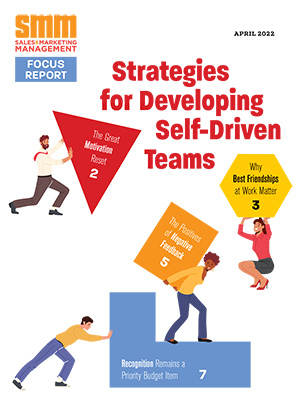To avoid the pitfalls of competing on price, salespeople are often told they need to “sell the value.” Selling the value implies the salesperson either truly understands what the customer values, or the value offered is perceived as significantly different from the competing offerings. All too often, neither one of these is true.
Another common strategy is to “value-add,” offering the customer extra services or product features without charge. A value-add strategy has its own drawbacks. While it may sometimes win a sale, it also produces customer expectations for “free stuff,” in addition to eroding margins. Not to mention, it may be easy for the competitor to match.
In short, while both of the above strategies can be effective in the short-term, neither produces a sustainable advantage. Nevertheless, salespeople tend to rely on these strategies—ineffective though they often are—because they find it difficult to achieve genuine differentiation based on something the customer values and is hard for the competition to replicate.
But suppose a salesperson were able to create a highly differentiated offering that provides real, unique value? The secret lies in going beyond easily commoditized features and services, instead developing what Ted Levitt called the “potential offering.”
Salespeople can achieve this type of differentiation by looking beyond their product to all aspects of the customer’s experience—across the whole process of buying and using a product or service. The “customer life cycle,” as it is sometimes called, provides a lens for understanding the experience at four critical phases, from buying the solution through the end of its useful life. Each phase offers an opportunity for an innovative salesperson to find sources of differentiation.
The following four steps are typical of the customer’s experience with a product or solution:
1. Shopping. Identifying the right solution and vendor options, establishing buying criteria, and making initial screening decisions.
2. Buying. Bringing a product or service through the process of contracting, financing, and paying, and receiving supplies and equipment.
3. Using. Installing and using the solution.
4. Disposing. Upgrading, recycling, discarding, and replacing.
By looking at each of these areas from the customer’s perspective, salespeople can identify opportunities to expand the offering. This may involve providing additional services or add-ons as part of the solution, or offering options that add value and generate benefits the customer can’t get elsewhere.
In the shopping phase, for example, there is great variability in how efficiently companies go about sourcing suppliers and alternative solutions, and how clearly and accurately they are able to define their search criteria. Suppliers can help by making their services and products easy to find and understand, and providing tools and expertise to help the decision-makers clarify technology and other requirements, as well as criteria for selecting a vendor.
The buying phase is usually overlooked by salespeople, who focus on their own company’s policies around contracts and agreements rather than on the needs of the customer. By better understanding how the customer buys, a sales organization can help the customer solve problems—offering leasing and financing options, for example, or helping the customer with elements of the purchase such as taking delivery of equipment or supplies.
Example: A salesperson selling janitorial and sanitation products to a group of hospitals came up with the idea of using a system similar to the one used for reordering pharmaceuticals (in this case, to automatically reorder the janitorial products as they were being used up).
Although usage and implementation are where most companies consciously add value to the offering, few look beyond initial installation and conventional service contracts. This is an area where innovation and in-depth understanding of the customer’s priorities and business processes can produce creative ideas, offering benefits unique to the customer.
Example: A salesperson working with a large distribution company helped them increase the efficiency of their warehouse operations by bringing in an expert from her own company. The latter changed the way products were being coded.
Depending on the product or service, the salesperson may be long gone by the time customers reach the dispose phase of the life cycle. Today, there are many new opportunities to differentiate at this point. Companies are beginning to emphasize recycling and reusing as “green” becomes a corporate value and goal. Salespeople can look for ways to help companies that must discard equipment or byproducts, provide options for recycling, or reuse of part or all of the product/equipment.
Example: A salesperson for a company selling paper products developed an innovative way for his company’s customers to help their customers recycle used office paper; this helped increase sales and customer loyalty. Another company provided a way for their customers to dispose of empty containers for one of their products that came in the form of an aerosol spray.
In a world where it is very easy for competitors to quickly duplicate even the most unique product features, it is still possible for a supplier to create a differentiated offering through creating individualized customer value competitors can’t easily provide. To help ensure your salespeople are expanding your offering to full potential value for each customer, ask yourself whether they are looking in the right places, across the full range of the customer’s experience with your company, products, and services.
Sidebar Quiz
Is your company reaching “full potential” value for customers? Answer “yes” or “no” for each of the following:
1. We make it easy for prospective customers to find us, as well as to understand our products and services.
2. We have the capability to offer expertise, tools, and other assistance to help customers determine their criteria for a good solution, and which solutions best fit their situation.
3. We offer various approaches for customers to acquire our products and services, such as different payment options, leasing, financing, etc.
4. We can and do help customers with logistics and other issues related to receiving our products and services.
5. We provide flexible options for support and assistance to customers in installing, implementing, and using our products and services.
6. We have a range of options available to help customers recycle, reuse, reduce waste, upgrade, and dispose of our products at the end of their useful life.
If you answered “yes” to all six questions, congratulations on meeting the criteria for creating a differentiated offering for your customers. You may, however, want to ask yourself whether all of your salespeople are consciously applying a life cycle strategy and are maximizing the potential for every customer.
If you answered “no” to all or most of the questions, you might want to raise your sales team’s awareness of the possibilities offered by a life cycle analysis. Try asking them to explore how to better differentiate by finding opportunities at each stage of the life cycle.
If your answers were split down the middle, analyze the questions and identify where you may be missing additional opportunities at some stages of the customer’s life cycle. Explore possibilities with your team, and raise their awareness of the value of looking across all four phases for differentiation opportunities.
Tom Roth is president of Wilson Learning Corporation (www.wilsonlearning.com), co-author of Creating the High Performance Team, and a frequent international speaker.
Is Your Sales Team Creating Real Differentiation?
Get our newsletter and digital focus reports

Stay current on learning and development trends, best practices, research, new products and technologies, case studies and much more.

